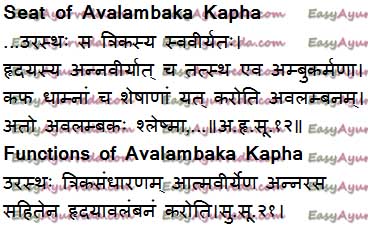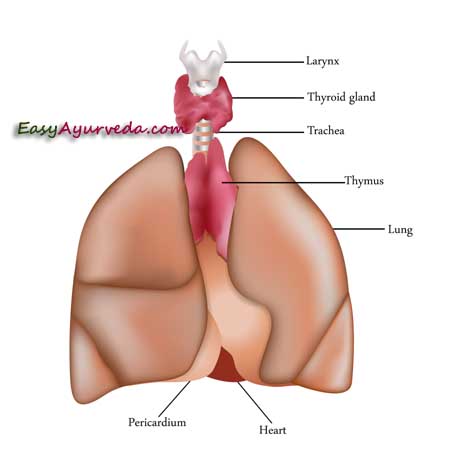Avalambaka Kapha – Location, Functions, Imbalance, Treatment
By Dr Raghuram Y.S. MD (Ay) & Dr Manasa, B.A.M.S
Avalambaka means support and dependence. Avalambaka kapha is ‘that which supports’ or ‘that on which the functions of the heart and lungs and other subtypes of kapha depends’.
Table of Contents
Introduction
Subtype of kapha which supports chest organs is called avalambaka kapha. Being located in chest and scapular region, being admixed with nutritional juice (ahara rasa, rasa dhatu), the avalambaka kapha supports heart and lungs and enables them to function in a comprehensive way.
Being located in chest, this subtype of kapha also supports and governs the functions of other subtypes of kapha.
Read – Sub Types Of Kapha – Importance, Salient Features
Avlambak Kaf is one of the five sub-types of kapha.
Location
Seat of Avalambak Kafa
- Uras i.e. chest cavity
- Trika i.e. scapular region
Being located in chest, the avalambaga kapha controls the integrated network of all kapha subtypes. Thus, chest is not only site of avalambaka kapha but also the control center of kapha. The scapular region is mentioned to indicate that this part of kapha is located even in the posterior aspect of chest cavity. Uras and trika in totality represents the entire chest cavity.
Read – Types Of Doshas And Their Functions
Sanskrit Shloka

Read – Understand Kapha Dosha By Its Functions
Functions
Functions of Avalambaka Kapha
Trika sandharana
Avalambaka kapha supports the trika i.e. triangular area on the upper back, between the two scapulae to be precise.
Trika in general terms means sacral region, the space in pelvis occupied by sacrum bone at the lower back. But Chakrapani, the commentator of Charaka Samhita defines trika as ‘the area connecting sacrum and both upper limbs’. This means trika is ‘the entire back region
According to Dalhana, commentator of Sushruta Samhita, trika is the region between head and shoulders and shoulders and heart. This includes scapular region and region under pectoralis major muscle.
Read – Udana Vata Location, Functions, Symptoms of Imbalance
Literally trika means a triangular area comprising of meeting place of three structures. In either of the explanations given by Chakrapanai and Dalhana as described above, trika seems to be meeting place of three structures making a triangular area.
In this instance, trika as a seat of avalambaka kapha can be considered as pectoral area and thorax in general.
This trika region comprises of heart and lungs with its coverings. One of the functions of avalambaka kapha is trika sandharana i.e. to protect and support the vitality of lungs and pleura and enable their normal functions.
Read – Home Remedy For Strength And Immunity In Chronic Lung Diseases
Thus, avalambaka kapha provides an environment for free expansion and relaxation of chest organs, mainly the lungs. This also enables easy aeration within the lungs and also enables free exchange of gases. The oxygenation of the blood takes place to optimum levels. Avalambakam kapham therefore provides a buffer system for free and effortless conduction of functions of lungs.
The heart with pericardium can also be considered in this instance because heart is also located in the same triangle and is a member of thorax. But since the authors have mentioned heart separately, I have considered lungs and pleura exclusively as constituting the trika.
Avalambak Kaph supports the contents of thorax i.e. heart with pericardium and lungs with pleura by its inherent power.
Read – What is Ojas? How To Increase Ojas During Health And Disease?
Hridaya sandharanam
Avalambaka kapha supports heart and its functions with the help of anna veerya i.e. nutritional essence (anna rasa, rasa dhatu). Heart is considered to be the root of annavaha srotas i.e. channels transporting nutritive substances all through the body. Therefore heart has an inseparable relationship with rasa dhatu.
Avalambaka kapha present in thorax with the help of this anna rasa would protect and support the heart. Heart supplies nutrition to all parts of body through circulation of blood. But heart too needs nutrition to survive and function. This is achieved by coronary blood vessels supplying the heart.
Read –Kapha Increase Symptoms – Kapha Vruddhi Lakshana
Nutritional components and oxygen in coronary vessels would enable heart to function properly. This is not enough. Heart is working throughout the life, to satisfy the demands of entire body, to enable all functions to go on effortlessly. With this the heart is constantly under friction and shock.
Avalambaka kapha located around heart would help in easy and effortless expansion and contraction of heart, which is very much essential for the heart to pump and receive blood throughout the life. This can be compared to pericardial fluid present around heart, enclosed in pericardium. Thus, the pericardial fluid i.e. Avalambaka kapha, along with Rasa tissue circulating in coronary vessels, together support heart and its smooth functioning.
Read – Activities And Diet For Kapha Balance
Anugraha
Kapha sthananam anugrahanam through ambukarma –
This subtype of kapha being located in its own place i.e. chest cavity supports and controls the abodes of other subtypes of kapha. Thus, avalambaka kapha is the controller and regulator of all other kapha subtypes.
Chest cavity which is an abode of avalambaka kapha is the control station of other kapha subtypes. This activity of avalambaka kapha is possible through its ambu karma i.e. water like functions. Thus, avalambaka kapha serves all the functions of water body.
Read – Udakavaha Srotas: Channels of water transport, Signs of damage, Treatment
Just like water, this kapha subtype nourishes resident places of other kapha subtypes i.e. tarpaka kapha and its abode head etc. With the same property it nourishes the entire body being located in the chest cavity. This kapha also causes dampness in body and keeps all cells and organs lubricated.
Pathology
Pathology related to Avalambaka Kapha imbalance
Imbalance of avalambaka kapha produces many diseases related to lungs and heart. Since it controls all other kaphas and their sites in body, the pathological increase or decrease of this chest kapha would cause imbalance and diseases related to other kapha subtypes too.
When this kapha becomes deficit, it causes excessive dryness in chest due to imbalance of fluid content around chest organs i.e. heart and lungs. This produces severe pressure over the functioning of these organs. This causes many diseases like pulmonary tuberculosis, atelectasis collapse of pulmonary alveoli, rupture of pulmonary vessels leading to haemoptysis, hypertension, rhythm disorders of heart, palpitations etc.
Excess avalambaka kapha causes excessive fluidity around the chest organs and causes diseases like pleural effusion, pericardial effusion etc.
Apart from this, diseases pertaining to the relative imbalance of other kaphas are manifested.
Read – Vyana Vata Location, Functions, Symptoms Of Vitiation

Modern correlation
Probable Modern Correlation
According to the opinions of different authors, avalambaka kapha can be compared to one or more of the below mentioned modern structures –
- Pleural fluid – enables free respiration by providing free and frictionless movements in the lungs
- Pericardial fluid – enables free movements of the heart
- Lung parenchyma – support pulmonary blood vessels and alveoli
- Mucin of the bronchi – provides free entry of air into lungs
- Coronary blood vessels – nourishes entire body and also heart
Treatment: Vamana, powder massage, herbal smoking etc Kapha balancing treatments are adopted.
Click to Consult Dr Raghuram Y.S. MD (Ayu) – Email / Skype









